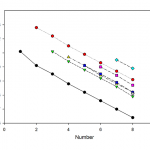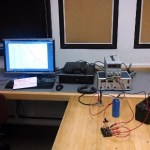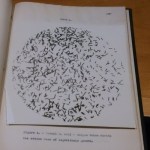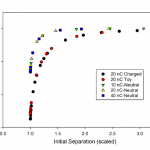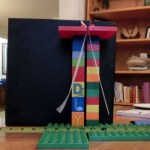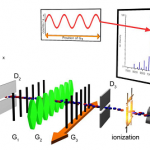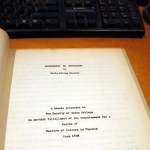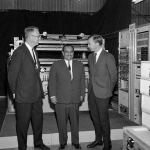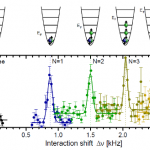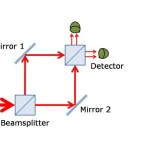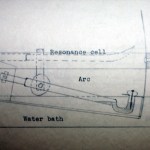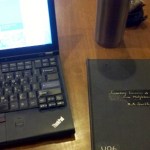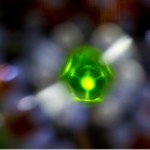Experiment
In which Rhett and I chat about the hot new discovery of primordial gravitational waves (maybe) very briefly before segueing into talking about LIGO, and Cosmos, and why "theory" is a terrible word, and the memorization of constants, and standardized tests, and time-lapse videos. You know, as one does.
Miscellaneous items:
-- I'm a little pixellated, as if I'm concealing my identity. I forgot to shut Kate's computer down, so it may have been doing online backups that chewed up bandwidth.
-- The von Neumann quote I butcher at one point is "The sciences do not try to explain, they hardly even…
Last week, we looked at the resistance of a voltage sensor by using the discharge of a capacitor, getting a value that was a bit high, but not wildly out of line with the specs. This time out, we're going to look at the resistance of a current meter, because some students asked about it during Wednesday's exam review session.
The question came up because one of the things I have on the standards for the circuit portion of the class is knowing how to hook up a current meter and a voltage meter in the appropriate ways. This is strangely confusing for a lot of students, which gets annoying, as…
For the latest in our ongoing series of post where I overthink simple questions, I'd like to present the longest single continuous experiment in Uncertain Principles history, which took six and a half hours yesterday. All to answer the question in the post title.
This may seem like a waste, given that I could download a spec sheet, but it was a simple extension of yesterday's lab. I'm teaching E&M this term, and we're wrapping up the circuits portion of the class. Yesterday's lab was about the discharging of capacitors.
This is one of those concepts that sneaks in largely as a way to…
In comments to the post on computer display colors, Will Slaton notes that Mac displays emit polarized light. And, indeed, this is an inherent part of the backlit LCD technology-- the individual pixels are bits of liquid crystal between two polarizers, and an applied voltage causes the liquid crystal molecules to flip between a state where they rotate the polarization of light, and a state where they don't. In one of those configurations, the polarizers block the light, and in the other, they let it pass. By rapidly varying the voltages, you can make the pixels flash on and off in the right…
This year's "Flame Challenge" is to explain color in terms an 11-year-old can follow. I have opinions on this subject, a background in AMO physics, and access to scientific equipment, so I'm putting something together. In the course of this, though, it occurred to me to wonder how my different portable computing devices process color. And since I have access to an Ocean Optics USB4000 spectrometer, I can answer this question in more detail than anybody needs.
So, I have three principal electronic devices that I use to do computer-type things: a Moto X smartphone, an iPad, and a Lenovo…
Back in the fall, I did a bunch of write-ups of old Master's theses that we found when clearing some space in a storage room. I got away from this because I was busy working on the book, but I have a few more that I pulled out to look at, and since all the other topics sucking up Internet energy at the moment are stupid or depressing, it seems like a good time to get back to these.
So, this is a thesis from 1934 by a fellow named Thomas Dietz, a combination of names that is common enough to make him less Google-able than you might want. This does seem to have been moderately significant work…
Topping the looooong list of things I would give a full ResearchBlogging write-up if I had time is this new paper on a ultra-cold atom realization of "Dirac Monopoles". This is really cool stuff, but there are a lot of intricacies that I don't fully understand, so writing it up isn't a simple matter.
The really short version, though, is that a team of AMO physicists have created particles that are analogous to magnetic monopoles-- that is, to a particle that was only a "north" or "south" pole of a magnet, not both together like a conventional bar magnet (leading to my favorite social-media…
I realize people are getting sick of reading me talk about this charged-tape business, which has run to one, two, three, four posts at this point. Truth be told, I'm losing enthusiasm for it myself. So this will be the final post, at least for now...
As I mentioned on Twitter, as I type this stuff up for the blog, I've toyed with the idea of hanging onto it instead, and writing it up for The American Journal of Physics or The Physics Teacher, so I could get a little professional credit for it. There are two problems with that (other than that some stick-in-the-mud editor or reviewer might…
Having spent a lot of time solving equations related to sticky tape models, including trying to work solutions in my head while driving to Grandma and Grandpa's with the kids, and making some measurements of real tapes, there was only one thing left to do: try simulating this problem in VPython. Because I'm a physics nerd who knows just enough about programming to be dangerous...
Finding the full solution to the real sticky tape scenario is kind of a miserable process, because it involves a long continuous tape with charge all down its length, which is kind of complicated, and then there's a…
In addition to making a toy model to show the tipping-point behavior of charged pieces of sticky tape, I spent some time on Tuesday trying to do something quantitative with this. Of course, Tuesday is the one day of the week that I don't teach, and I didn't want to go to campus to do the experiment, so I put it together from the incredibly sophisticated materials I had available at home: Lego bricks and a tape measure belonging to SteelyKid and The Pip.
Having built this high-tech rig, I set up my new video camera on the tripod, and shot some videos of the key phenomena. First, there's the…
I got a new camera for Christmas, not because there's anything wrong with my DSLR, but because I wanted something that could do high-speed video. So I now have a Casio point-and-shoot camera that will record up to 1000 frames per second, woo-hoo!
To break it in, I got the kids to help out by re-creating a classic slow-mo physics trick: the slinky drop:
Note that when SteelyKid lets it go, the bottom doesn't really move until after the entire length of the spring has relaxed. You can clearly see this in the still frame that's the "featured image" at the top of the post.
And since The Pip has…
I'm teaching Quantum Optics this term, and one of my students picked "Atom Optics" off the list of suggested paper topics. When he asked for pointers, I said "You should check out the diffraction stuff Markus Arndt's group does." And just like that, a paper from the Arndt group turns up from the Arxiv Blog...
This is apparently only recently posted to the arxiv, though the article in Physical Chemistry Chemical Physics claims to have been online since July. Since I never get tired of talking about this, let's talk about this one, too.
So, what's this one about, then? In a lot of ways, it's…
One of the interesting things about the pile of old theses we found in the basement is the opportunity to look at things that nobody believes any more. Past installments of the Old Thesis Club have shown people fumbling toward an understanding of quantum physics via electron scattering and spectroscopy, but in both of those cases, they were working toward a correct theory. In this edition, we look at an investigation of a theory that's been wholly discredited.
The general category of the experiment isn't problematic-- it's basically a test of the equivalence principle, the idea that the…
In 1967, a team of scientists hauled a big pile of gear-- electronics, particle detectors, a giant slab of iron-- into the burial chamber at the base of one of the pyramids at Giza. This sounds like a scene from a science fiction or fantasy novel-- throw in the fact that their first attempt was interrupted by the Six Day War and you've got an element of a Tim Powers secret history story-- but the goal wasn't the opening of an interdimensional portal or the raising of the dead. Instead, they were using astrophysics to do archaeology: their detectors measured the number of cosmic ray particles…
Two papers with a similar theme crossed my social media feeds in the last couple of days. You might think this is just a weird coincidence, but I'm choosing to take it as a sign to write about them for the blog.
So, what are these papers, and what's the theme? One is the final publication of some results I saw at DAMOP and alluded to back in June, and the other is from this post by Doug Natelson. Both look at the transition from few-body to many-body physics.
And this is interesting, why? I mean, isn't it obvious that you just add some more bodies? OK, I guess that does need a little more…
When I posted congratulating the winner of this year's Nobel betting pool, I received a gentle reminder in email that I'm a Bad Person and still haven't done one of the posts I owe to the 2011 winners. Evan reminded me that he asked for something about the delayed-choice quantum eraser, so let's talk about that a bit, in the traditional Q&A format.
So, what's a delayed choice quantum eraser do? It may or may not have rubbed out mistakes you made while writing, but you don't know until later when somebody else chooses to read it? Nothing physical gets erased. The delayed-choice quantum…
Having spent a bunch of time talking about heavy stuff in the science blogging community, let's unwind a bit and kick the week off with a look back at an old Master's thesis. This one is from 1932, and is almost certainly a draft copy, because it's extremely cheaply bound in cardboard with the title hand-lettered on the front. There are a few corrections in the text as well, which is very short-- just 11 pages, not counting the figures at the end.
Again, this is interesting as much for what it doesn't contain as what it does. The subject matter is pretty mundane by modern standards-- just…
As noted in a previous post on Monte Carlo simulation in 1960, we recently came into possession of a large box of old Master's theses. The bulk of these are from the 50's and 60's, but there are some going back much farther. As I pass these every day I'm in the office, I thought it might be amusing to take a look at these for the blog, now and again. I don't plan to do a detailed examination of the quality of the science (at least, not necessarily), but to use this to look at how things have changed over the decades.
The first of these, pictured above, is one of the oldest: Secondary Emission…
Through some kind of weird synchronicity, the title question came up twice yesterday, once in a comment to my TED@NYC talk post, and the second time on Twitter, in a conversation with a person whose account is protected, thus rendering it un-link-able. Trust me.
The question is one of those things that you don't necessarily think about right off-- of course an atom is a particle!-- but once it gets brought up, you realize it's a little subtle. Because, after all, while electrons and photons are fundamental particles, with no internal structure, atoms are made of smaller things. But somehow we…
Element: Ytterbium (Yb)
Atomic Number: 70
Mass: Seven "stable" isotopes, from 168 to 176 amu. Two of those are nominally radioactive, with half-lives vastly in excess of the age of the universe.
Laser cooling wavelength: 399 nm and 556 nm.
Doppler cooling limit: 690 μK in the UV and 4.4 μK in the green.
Chemical classification: A rare earth/ lanthanide, one of the hard to distinguish metals in the little island that floats off toward the bottom of the usual presentation of the periodic table, because it's too hard to wedge them in between barium and hafnium. Yet another greyish metal.
Other…
